Another Look At Ultrarich Preppers, Postscript: How About "Getting Out Of Dodge"?
After looking at "Doomsday Prep For The Super-Rich" from an essentially sociological angle, through with a lengthy introductory digression on an EMP attack, I took a broad-brush look at four of the methods settled on by Wall-Street- and Silicon-Valley preppers; it was split into two parts. The first part looked at sheltering-in-place, or bugging-in; the second looked at four different methods of bugging-out, or taking refuge in a rural or specially-designed retreat.
The latter - the bugging-out option - brings up a necessary question, though: how do you get to it? How, in a real disaster, do you get out of Dodge?
The Multi-Tool Of Prepping: The Bug-Out Bag
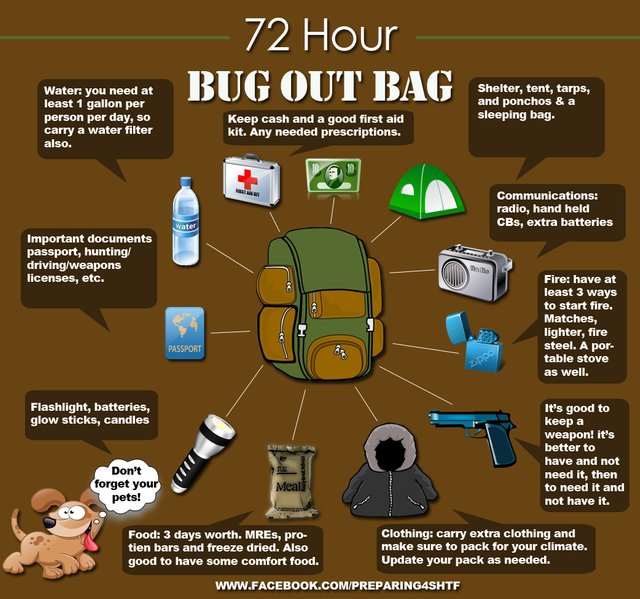
I'm tempted to call it the "monkey wrench" of prepping, because it's so central to any serious prep plan. As the above image shows (it's from here), a bug-out bag is a backpack stuffed with enough supplies to keep you going in the woods or on the road for 72 hours: three full days. Interestingly, it's also the most mainstream part of prepping. Many disaster-relief organizations (including the notorious FEMA!) have advice and tips on what to put in a bug-out bag. Wikipedia's page on 'em is here.
Perhaps inevitably, the centrality of the bug-out bag means that there's hundreds of pages worth of advice on what to pack. Like an old-fashioned school notebook, every prepper dishing out advice seems to personalize the basic package by adding "doodles": use this type of parachute cord, that type of knife, etc. Despite all this variety, the consensus is that the weight of the bug-out bag should be about twenty-five pounds.
There's unanimous agreement that the bag is supposed to be an aid to get you to your retreat. It's not supposed to serve as a substitute for a well-stocked retreat. There's only so much you can carry on your back.
Given the standard part of the recommendations, there's a three-day soft limit in travel time between you and your retreat. And that brings up the central subject of this post: how do you get there? What are the advantages and disadvantages of each mode of travel? To make things exciting, I'm assuming an all-out SHTF disaster or something close to it.
Bug-Out Methods: Advantages And Disadvantages

(Image from here.)
1. The Trusty Reliable Car or Truck
The advantage of bugging out in your car is obvious: in a word, normality. Taking the car or the good ol' truck means that bugging out is just like taking off for a vacation, only a bit hurriedly. :) A car can deliver hundreds of miles of travel on a full tank, and even more if you pack one or two 5-gallon jerry cans' worth of gas. You can also pack in a lot of gear, especially if you have a trailer hitch and a serviceable trailer.
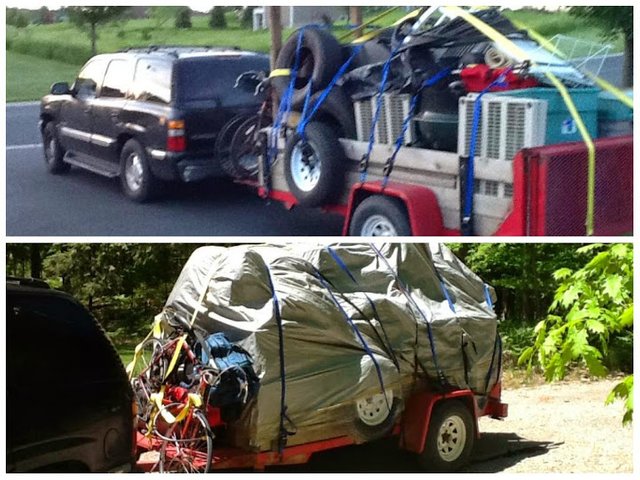
I'm sure you know what the disadvantage is: traffic jams! Once you're stuck, you're stuck...
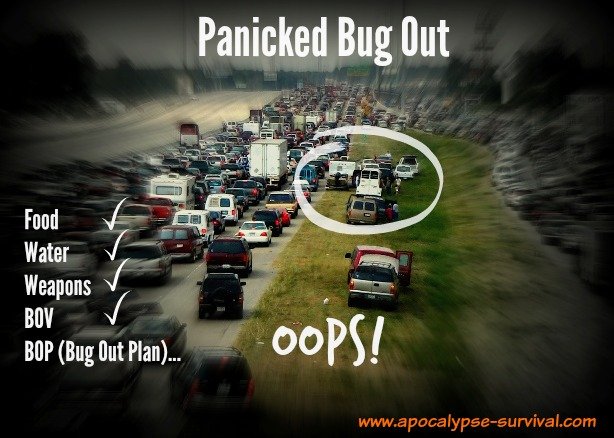
If an EMP attack fries a lot of cars on the road, you'll be really stuck. Perversely, this is a point in favor of using an RV as your portable bug-out locale :-)
Comment: Using the car or truck only makes sense if you get out before the Big One hits. This isn't as difficult as it may sound. For both Katrina and Sandy, meteorologists were warning about trouble 24 hours before both hit. From what I recall, there were no traffic jams in that 24-hour stretch. The grocery shelves weren't pillaged in that timeframe, too. Based upon prior disasters, you can get out with your car if you anticipate the disaster.
The trouble comes with false positives: bugging-out only to find there was no need to. Since vacation time is hard to come by these days, the anticipatory option isn't that feasible unless you have permission to telecommute and have Internet in your bug-out location, and agree to a "working vacation." The false-positive problem is most likely to come with anticipating an act of war.
2. The Off-Road Truck Of Your Dreams
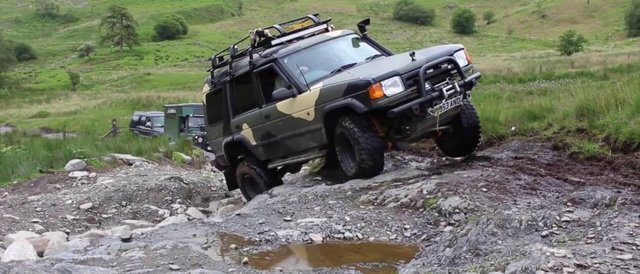
The advantage to this mode of transport is that it combines the normality/capacity of a car or truck with greater mobility. Who hasn't seen those Range Rover commercials which feature the thing sailing through an unpaved field? True, this option will not endear you to the farming folk if you use its special capacities. ;) But, it does give you a way to get around a traffic jam.
That said, an important disadvantage to these vehicles is that they're expensive. They're also gas hogs. If you plan to use one, it would be prudent to have three or four filled-up 5-gallon jerry cans of gas.
Another important disadvantage is that these things' mobility can be stymied by something as simple as a river or blasted-out bedrock hill.
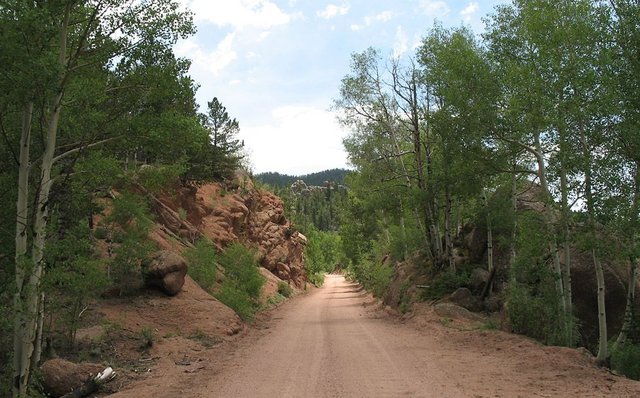
If this section of the road get bedeviled by a traffic jam, a Range Rover or Hummer won't be of much help.
Another vehicle-blocker is a group of trees that are too close together. The trouble with these beasts is: once you're stuck, you're stuck unless you have a working winch that can pull you out of trouble.
Comment: if this is the option you're tempted by, it''s very important to take a close look at the highways you normally use to get to your retreat. If it's all fields or flattish terrains on the sides, you're good. If not, it's best to find out in advance.
3. All-Terrain Vehicle
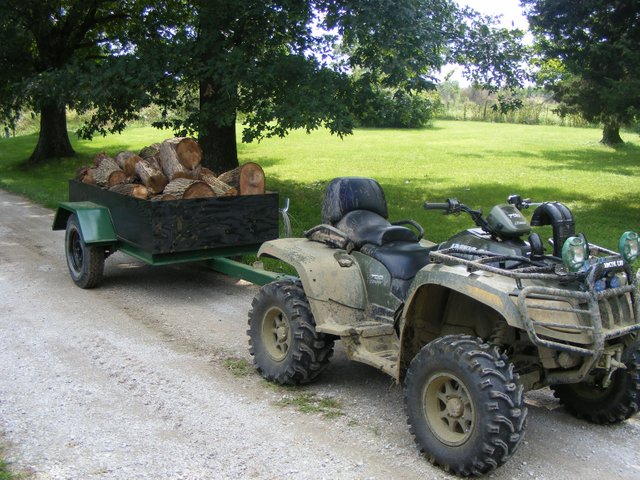
As the image above shows, an ATV is damned useful in a rural bug-out location. Even if it's dependent upon gasoline, it's still a lifesaver so long as gas (including stored gas) is available.
It';s also an intriguing alternative to get to your bug-out location, even if storing one in your front yard would raise eyebrows. :)
When compared to #2, it has two advantages. First of all: an ATV is much cheaper than a military-grade Hummer or Land Rover. Secondly: even with a trailer, it's far more mobile than even a premium off-road vehicle. An ATV is narrower - about three feet or so - so it can slip through paths, crevices, etc., that are narrower than an off-road vehicle can handle. Its tires are designed to cover rougher terrain. As with the off-road, you can pack a lot more than a bug-out bag: for example, you can belt a 5-gallon jerry can of gasoline.
Its main disadvantage is that it's neither fish nor fowl. It's not a vehicle that can transport an entire family, except through the somewhat hazardous means of some of 'em riding in the trunk. Threeish feet, though narrow, is not narrow enough to ride comfortably between lanes on the highway. Like the off-road vehicle, you're sorry and out of luck if your off-road path is stymied by a river. And like the off-roader, it's too heavy to lift up if it gets stuck or wedged.
Also, its top speed is about the same as a manual bike. To make any real distance, you will have to include that filled 5-gallon jerry can: perhaps two.
Comment: Risky. It might make sense as a backup transport, as as a less inconvenient means to get your entire family to the bug-out location. If the latter, the trailer should be fitted with padding. This vehicle might come into its own in an all-out SHTF scenario. But so long as there's rule of law, you risk trouble from the highway patrol if you drive it on the roads.
(Image from here.)
4. Motorcycle
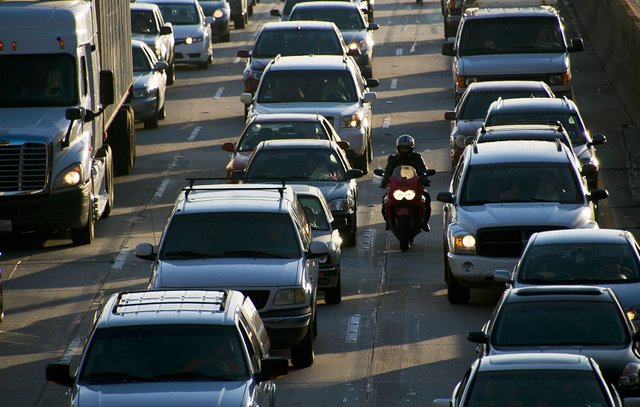
As the picture makes clear, the most important advantage to a motorcycle is narrowness. If you're facing a traffic jam, you can drive right through!
This feature is so apparent, a lot of clever folks think that a motorcycle is ideal. You might be able to get to your bug-out location on a single tank of gas, without even a bug-out bag. Since a cycle can reach the same speed as a car, even several hundred miles amounts to a day trip.
Except...there's one glaring disadvantage: in a word, road rage. The folks stuck in cars aren't going to like seeing a motorbike zippity through them. The risk here is, some will be resentful enough to actively block your path by something as simple as opening their doors to block the 'tween-lane thoroughfare - or even the shoulder.
If you've read the works of Colin Flaherty, you know that there are some nastier things some disgruntled folks can do to someone on a two-wheeler....

Another, though lesser, disadvantage is that it's more difficult to carry along spare gasoline - particularly if you're prudent enough to wear a bug-out bag on your back.
Comment: In some ways, a motorcycle is ideal - but it's also socially risky. Of note: a motorbike is the vehicle that most needs a backup self-defense plan (and implements.)

Also: you should practice driving up to your bug-out location, while wearing your bug-out bag, enough times to get comfortable with the backpack. At least, enough times to get an idea of how much gas you'll need to make the real journey.
(Images from here, here and here.)
5. Dirt Bike

If you're jazzed about a motorcycle, allow me to present an alternative: the humble yet exciting dirt bike. Its chief advantage, particularly if you're good an experienced at riding one, is that it's much more mobile than a motorcycle. You will have to sacrifice top speed, but you can get to your bug-out location without your wheels touching pavement except to cross a road. Instead of taking the social risk of 'tween-laneing, you can bypass the highway entirely. And make good time, too.
This is the main advantage of a dirt bike. A related advantage: dirt bikes are light. If you're strong, you can carry one over a rough spot - or even through a shallow river.

That's something you can't do with any of the foregoing.
Also - and this is true of the ATV - you can make your way via a train-track route or a grid easement.
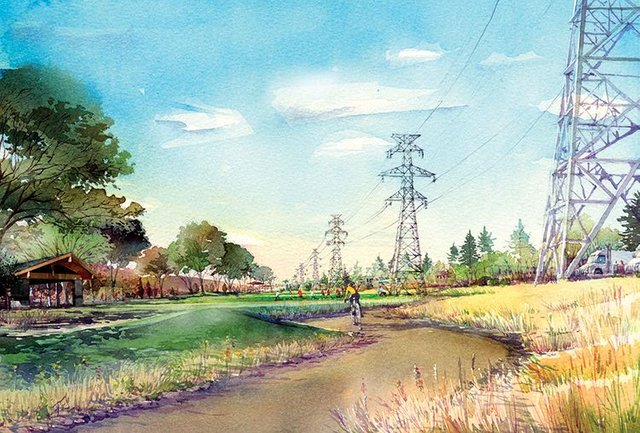
But the dirt bike does share a common disadvantage with the ATV: it's not street legal. You can't practice directly except in your imagination, unless you want to risk bumping into the highway constabulary. Related to this is the trouble of fuel: you'll have to estimate how much gas you need to bring along to get you where you want to go.
Comment: This is a great choice if you're going solo, or if you have a partner who likes driving a dirt bike too. This vehicle's for the solo rider, which makes it problematic for someone with a family that includes young kids.
(Images from here, here and here.)
6. Mountain Bike
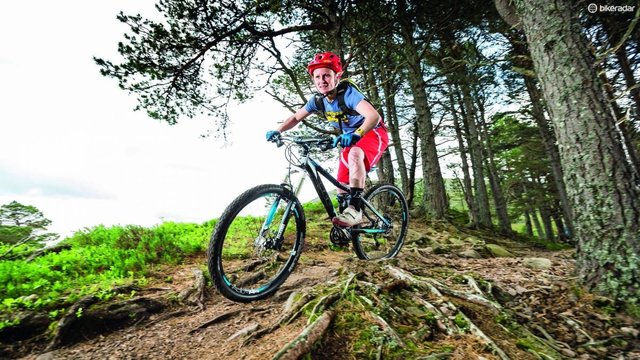
You can see one advantage from the picture: a mountain bike can be driven by a small child! That's a relief if you're bugging out with a family.
Another advantage is that a mountain bike is just as mobile as a dirt bike but it's lighter. Conceivably: if you can't drive over a bridge spanning a river, you could ford through the river itself while carrying your bike. Or: you can 'tween-lane or try the shoulder, because a bike is street legal except for superhighways. Yet another advantage is that you need no fuel. So long as your bug-out bag supplies hold up, you can keep going.
Of course, the chief disadvantage is contained in the last advantage. You're the motor! So, the bike option requires a lot of preparatory exercise. Due to it being street legal, you do have the opportunity to make at least one dry run for real to see how you hold up.
Another disadvantage is that a mountain bike is much slower than the above, except for an ATV. You also have to be comfy keeping your balance while wearing your bug-out backpack.
Comment: The mountain bike looks like a durn good choice. Its fuel-free nature means you can go for as long as you have legs; you're only constrained by strength and food. It's also the most mobile family-friendly option. Provided you can tough through biking in the rain, this one's hard to beat unless you have a need for speed.
Unless you're lucky enough to have a wilderness-area bug-out location that's fairly close, though, your bug-out trip will be longer than a day trip. So with this option, you have to take special care that everyone's bug-out bags are well-equipped and topped up.
(Image from here.)
7. Walking
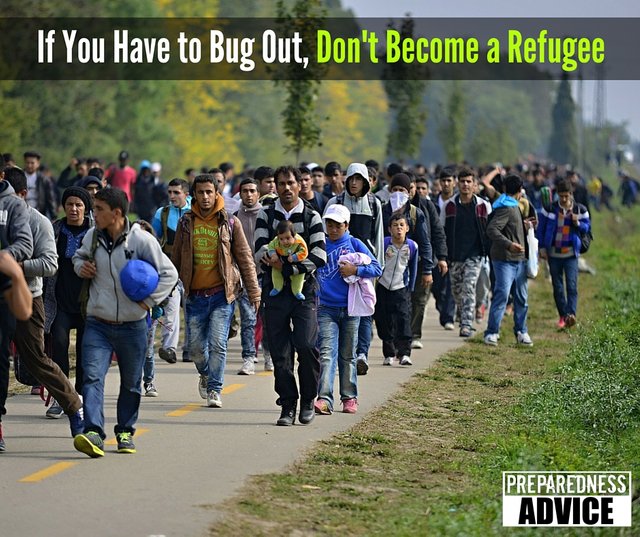
In many a way, walking is the booby prize of the list: the choice of last resort. As someone who's made a few monster hoofs, I can tell you flatly: you'll be lucky to make twenty miles in a full day. This poses a real problem if you're stuck in a megalopolis. What would you do if it's the end of the day, you're looking for a place to camp out for the night, and you're still in the exurbs?
If you have a family with kids, it'll be a lot less than twenty. You're looking at the suburbs for your first bed-down.
But this has a compensatory advantage. So long as you're near civilization, there's a good chance you'll be spending your first overnight (or first two overnights) in a comfy motel. With this in mind, it's an especially good idea to make sure you're carrying lots of folding money. Even if the SHTF, most folks will still be in denial long enough for you to pass on your green.
Another advantage is one shared by the mountain bike: so long as you can feed yourself, you can take as long as you like. Walking is also the most mobile option there is. It's a lot more difficult to climb a fence (for example) if you have to carry up a bike with you.
But the final advantage is a more subtle one: to make sure you can do the walk, you'll need a lot of practice. That means getting a lot of exercise: cardiovascular exercise. Choosing and preparing for the walking option will make you a lot fitter than any of the others.
But as I indicated above, this option has enough disadvantages to make it the choice of last resort, unless you're a fitness nut. :)
(Image from here.)
Conclusion:
All things considered, the car is best if you can afford to get out of Dodge before the disaster strikes, at the pain of false positives. If you work on the Internet, are a free-lancer, have an independent income, or have an understanding boss (which these days means agreeing to telecommute and do your job in your bug-out location), the car & trailer are the best choices...provided that you follow through on getting out before the disaster strikes. This necessity will require you to keep a close eye on the news, including the weather part.
If you don't have that time-flexibility, the mountain bike is best because it's the most terrain-flexible. True: it takes much longer than a nice vehicle, and you will be huffin' and puffin', but so long as you don't run out of food you won't have a deadline. It's the best of Hobson's choices.
But I wouldn't write off walking, as it's the "vanilla" of them all. It's not a good first choice, but it's a serviceable backup choice. It's there for you if any vehicle breaks, or is stolen.
(BTW: One hidden advantage of walking is that the same fellow who'd rage-block you if you were 'tween-laneing in a motorcycle would likely sympathize with you if he saw you shambling tiredly along the road. That sympathy might count in a pinch.)
Thanks for reading! Any ideas of your own? Drop 'em in the comments!

(Image from here; thanks to @albertogm .)
good advice on the vehicles, and on staying away from the herd in a refugee situation.
the only thing I would add is that people should not discuss their weapons preparation portion of the BOB plan unless they are completely anonymous
you never know who is listening
Worth repeating, especially since a nation-scale disaster would prolly see the government assume national-emergency or even war powers.
really enjoyed this nxtblg great job putting this together
Thanks a lot!
Sorry I missed it earlier!
https://twitter.com/Soul_Eater_43/status/828044261836935170
Hey: I'm glad you found it at all!
Hoping it'll being more folks in...
Yes I think these kind of posts will. Keep it up:)
Thanks; will do.